BAD SCENOGRAPHY: A CORROSIVE FOR ART
A sofa in upholstered fabric, a bookcase in solid oak, in short a Roche Bobois furniture that participates in the imitation of a collector’s interior through which it was necessary to pass if one wanted to discover the 6th edition of fotofever. This weekend, the Carrousel du Louvre photography fair reissued a scenographic proposal orchestrated by Élizabeth Leriche entitled “L’appartement du collectionneur”. It thus forced visitors wishing to access the fair to go through this first step before reaching the classic stands of this type of event. On the walls of the 200m2 of this fictional apartment, the photographs of the artists chosen to join the initiative are a little forgotten among the cartels indicating the price of Roche Bobois furniture.

If only this curatorial essay had only its scandalous lack of elegance in substituting a commercial operation for a desire to democratize the act of collecting. This attempt is unfortunate because it is part of those initiatives that simply serve the work of artists. Certainly, the works of this fair, dedicated to the collection of contemporary photography, were all intended for sale and ultimately, on the walls of a private apartment. That is all we can wish for artists: that their work be bought. But by presenting works in this way, the organizers of fotofever are changing the status of photography and, more importantly, contemporary art. Matching the works to the colours of the walls of this reconstruction means reducing them to a state of decoration. It is to deny what an artist’s work is fundamentally: to think of his time, to embellish it, to caricature it or to criticize it. More than a mere clumsiness, this apartment is a contempt that should not be underestimated and that must be fought against because it puts the work of artists in danger. Of course, it is obvious that we must think about a new way of exhibiting art, even the one we want to sell. But the staging of this antechamber, delegated to a furniture store and the director of a design office, is not the solution.

This paper is not a praise of the white cube or even an indictment against the showroom. Curatorial attempts are relevant as long as they do not reduce works of art to their aesthetic problems alone and do not instil doubt in the mind of the visitor who would no longer know whether he is in the aisles of a fair reserved for contemporary art or in those of a Swedish chain of standardized furniture.

In short, the proposal of the organizers of fotofever reveals a real fundamental problem: we do not fully understand the need to take care of artists. Art schools do not train future advertisers or interior designers. No, they are the incubators of our ability to analyze the world of today and tomorrow – a mission that I will not take the time here to defend as its necessity seems obvious to me. Let us not despise the work of artists, let us protect it.






